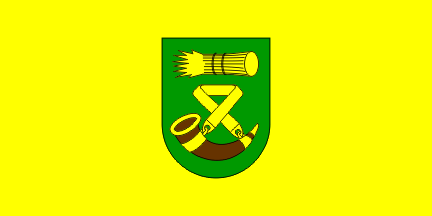
image by Željko Heimer, 26 April 2004

Last modified: 2008-07-05 by dov gutterman
Keywords: osijek | baranja | osjecko-baranjska | croatia | osijek baranja | bilje | barley |
Links: FOTW homepage |
search |
disclaimer and copyright |
write us |
mirrors

image by Željko Heimer, 26 April 2004
See also:
Other Sites:
It seems that in the mean time they changed the symbols (the Previous one was current around 1998).
Unfortunately, the image I have drawn shall have to pass as
provisory, as I have no good details of the Coat of Arms.
The coat of arms is Vert a hunting horn proper and in chief a
garb fesswise or. The flag is (almost definitevly) yellow with
the coat of arms in the middle.
There is also a ceremonial flag, with fly ending as triangule,
with the coat of arms in the middle, green inscription of the
community name above and two green branches below.
The ceremonial flag I saw few days ago in an interview with a
local official, as a table flag. From it I assume that the normal
flag would be yellow, too, which is quite resonable assumption.
The coat of arms is shown on the official web site of the
community at <www.bilje.hr>
(unfortunately only very small image, no description no on line
documentation that I found).
Željko Heimer, 26 April 2004
There table flag is ending as triangle,
with the coat of arms in the middle, green inscription of the
community name above and two green oak branches below.
The symbols of Bilje were designed by Heralid Art d.o.o from Rijeka.
Željko Heimer, 3 November 2007

image by Željko Heimer, 3 November 2007
os-bl.gif)
image by Željko Heimer, 26 April 2004
The plant showed on Bilje flag is not wheat but three-row
barley. The difference is to be seen in the geometrical
arrangement of grains, which are arranged in rows (3 or 6) in
barley and in quincunx in wheat. This is difficult to figure out
but evident if you have two barley and wheat spikes in the hand.
It is often reported that only barley spikes have awn, but
several wheat varieties, including modern popular ones, have awn
too.
Awn is the generic terms for the "hairs" which emerge
from the spike and cause unpleasant itching and allergy to
experimentators. In the early time of manual harvesting, breeders
tried to eliminate awns. This elimination is now unnecessary
because of mechanical harvesting and quite common linkage between
awn presence and interesting characteristics.
Ivan Sache , 27 October 1999
Information provided by Leo Rakovac (Opæina Bilje):
"Community of Bilje is located in Baranya, north of
Osijek.The importance of agriculture, in first place grain
production is showed with three wheat stalks. National park of
Kopacevski Rit, marshy region around confluance of Drava in
Dunav, provided food to the inhabitants for centuries, and is
still today very atractive fishing area. "
Željko Heimer